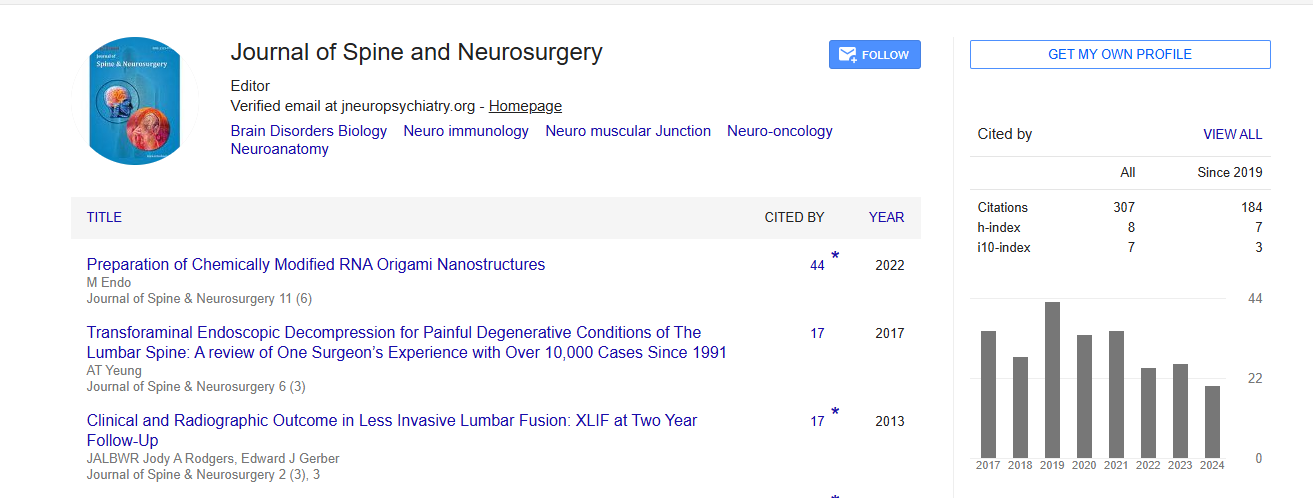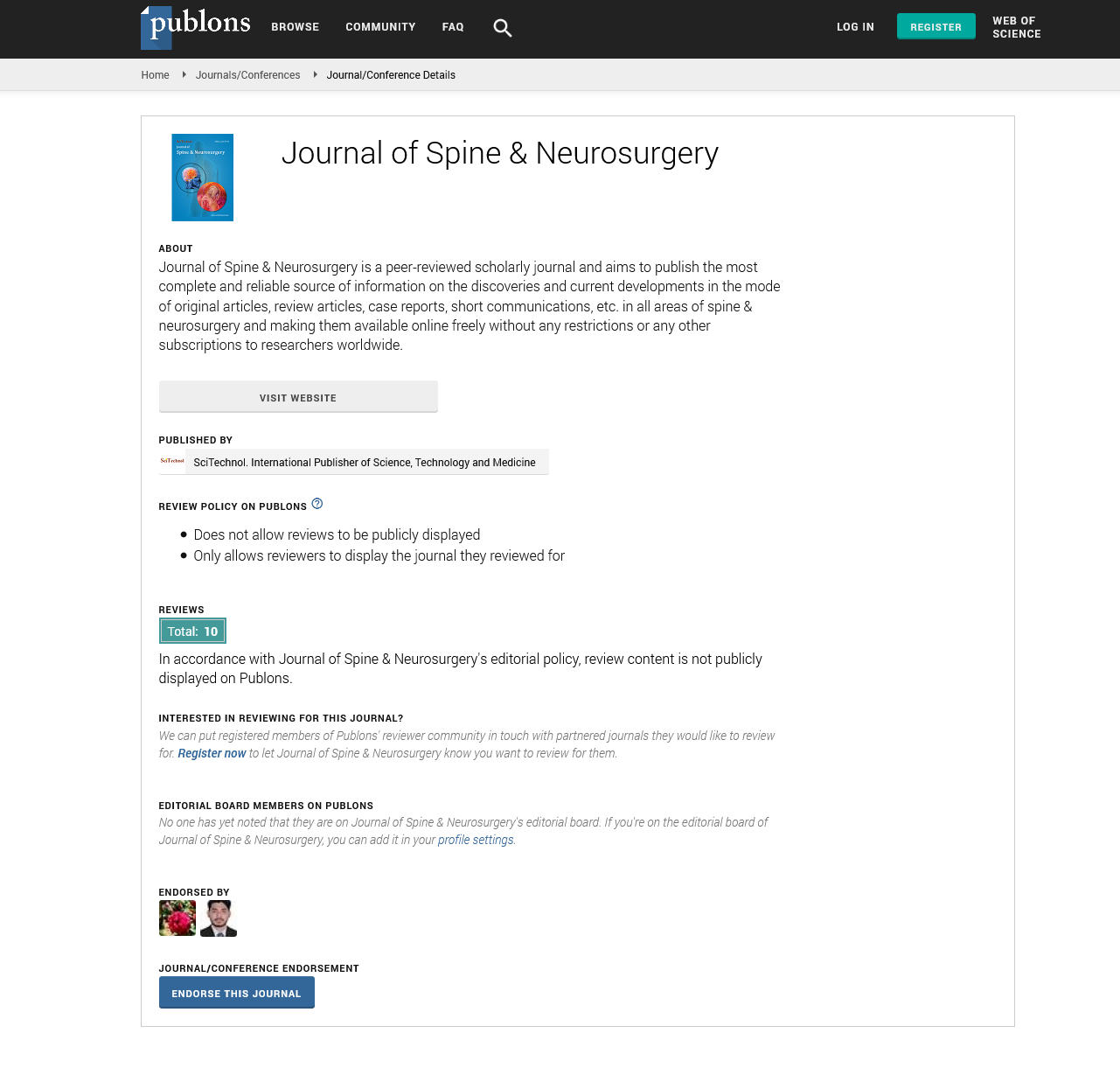Perspective, J Spine Neurosurg Vol: 12 Issue: 6
Navigating Tardive Dyskinesia: Symptoms, Causes, and Management
Xinchi Yan*
1Department of Psychiatry, Mental Health Center of Tianjin Medical University, Tianjin, China
*Corresponding Author: Xinchi Yan,
Department of Psychiatry, Mental Health
Center of Tianjin Medical University, Tianjin, China
E-mail: xinchi_01yan@gmail.com
Received date: 27 November, 2023, Manuscript No. JSNS-24-128412;
Editor assigned date: 29 November, 2023, PreQC No. JSNS-24-128412 (PQ);
Reviewed date: 14 December, 2023, QC No. JSNS-24-128412;
Revised date: 21 December, 2023, Manuscript No. JSNS-24-128412 (R);
Published date: 28 December, 2023, DOI: 10.4172/2325-9701.1000191.
Citation: Yan X (2023) Navigating Tardive Dyskinesia: Symptoms, Causes, and Management. J Spine Neurosurg 12:6.
Description
Tardive Dyskinesia (TD) is a neurological disorder characterized by involuntary, repetitive movements, typically involving the face, tongue, and other parts of the body. Often associated with long-term use of certain medications, TD presents a unique set of challenges for both patients and healthcare professionals. This aims to illuminate the complexities of Tardive Dyskinesia, exploring its causes, symptoms, and current therapeutic insights. Tardive Dyskinesia is primarily a side effect of prolonged use of certain medications, particularly antipsychotics and other drugs that affect dopamine levels in the brain. These medications are commonly prescribed to treat psychiatric conditions such as schizophrenia, bipolar disorder, and certain gastrointestinal issues. The risk of developing TD increases with the duration of medication use. The underlying mechanism of TD is believed to be related to dopamine receptor dysfunction in the brain. Dopamine, a neurotransmitter, plays an important role in regulating movement and coordination. Prolonged exposure to medications that interfere with dopamine receptors can lead to an imbalance, resulting in the involuntary movement’s characteristic of TD.
Symptoms
The symptoms of TD include repetitive and purposeless movements, such as lip smacking, tongue protrusion, facial grimacing, and involuntary movements of the limbs or trunk. These movements can be distressing for individuals affected by TD, impacting their daily activities and contributing to social stigma. Certain factors increase the risk of developing Tardive Dyskinesia. Older individuals are generally more susceptible, as are those with a longer history of exposure to antipsychotic medications. Women and individuals with a history of substance abuse may also face an elevated risk. Genetic predisposition may play a role in determining susceptibility to TD.
Diagnosis and treatment
Diagnosing Tardive Dyskinesia requires a careful assessment of the patient's medical history medication usage and a thorough neurological examination. Recognizing the symptoms early is vital for intervention and management. Healthcare professionals may use standardized rating scales to assess the severity of TD and monitor changes over time. The first line of action in managing TD involves reconsidering the use of the implicated medications. However, abrupt discontinuation of these medications can exacerbate psychiatric symptoms, necessitating a delicate balance between symptom controls and minimizing TD risk. Switching to alternative medications with lower TD risk may be an option. Various medications have shown efficacy in managing TD symptoms, including Vesicular Monoamine Transporter 2 (VMAT2) inhibitors like deutetrabenazine and valbenazine. These drugs work by regulating dopamine levels in the brain, helping to control involuntary movements associated with TD.
Living with Tardive Dyskinesia can be emotionally challenging. Psychosocial support, including counseling and support groups, can offer individuals coping mechanisms and a sense of community. Education about the condition and its management is essential for both patients and their caregivers.
Conclusion
Tardive Dyskinesia is a complex neurological disorder that arises as a side effect of certain medications. While the management of TD poses challenges, there is hope in emerging therapeutic approaches and a growing understanding of the condition. With continued research, improved diagnostics, and a multidisciplinary approach to care, the medical community endeavors to enhance the quality of life for individuals affected by Tardive Dyskinesia. Increased awareness and support contribute to breaking down the stigma associated with this condition, fostering a more informed and empathetic approach to those navigating the complexities of TD. Ongoing research is focused on understanding the underlying mechanisms of TD and developing targeted therapies with fewer side effects. Advances in pharmacogenomics aim to identify genetic factors that may influence an individual's susceptibility to TD, allowing for more personalized treatment approaches.
 Spanish
Spanish  Chinese
Chinese  Russian
Russian  German
German  French
French  Japanese
Japanese  Portuguese
Portuguese  Hindi
Hindi 
